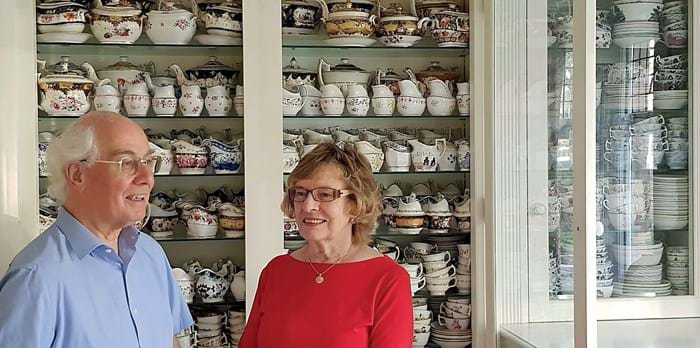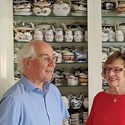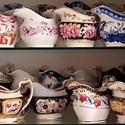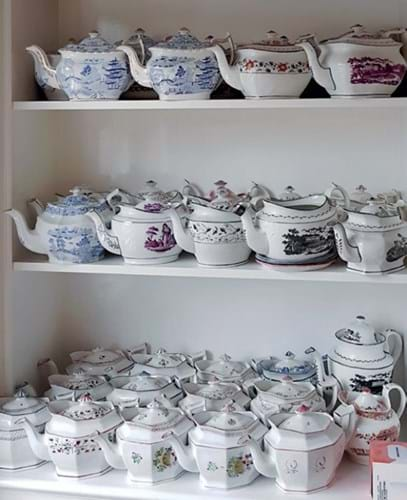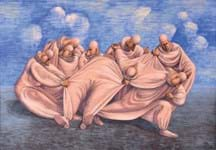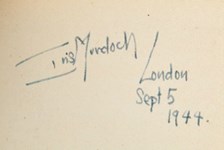Ian Harvey began with stamps as a teenager and from the 1990s developed a significant collection of Rathbone and related Regency china. With his wife Jenny he also collects antique maps, including those of the Potteries, and she trained some 15 years ago to repair and restore ceramics, all helpful to the china collection.
They are members of the English Ceramic Circle, the Northern Ceramic Society and the London Ceramic Circle.
ATG: How did you get the collecting bug?
Ian Harvey: Maybe I was born with it! Having been a stamp collector from an early age, one tends to get interested in other things too. I have been retired 20 years and have been a serious collector most of my life.
What drew you to Rathbone and related Regency potteries particularly?
Going back 30-35 years, my wife and I had been interested in porcelain but found it difficult to create a focus for a collection. If you don’t have a focus you can fill up a shelf, a barn and a house pretty quickly just buying what you like.
Then in 1994, I found a little shelf on a stand at the Antiques for Everyone fair at the NEC of some 1820s Regency china with the name Rathbone. This is a name that stood out for me as I was finance director of an investment management company called Rathbone. The dealer, Reg Turner from Chesterfield, told me a bit about them and, as a couple of the pieces had the Rathbone name on the bottom, I started collecting.
What’s the most you have ever spent on an item?
Values have come down a lot. In good condition, which is rare, cups with saucers are now around £40 and teapots £150.
The most I have spent is £850 for a railway jug. This was because of particular demand as it is also an item of railway memorabilia. If you want to be a serious collector of ceramics, this is a great time to buy.
What tips would you give to would-be collectors?
Join the societies in your chosen field. They are the lifeblood of the collecting world. Being involved creates a social environment, helps you to decide what to collect, allows you access to other collections, and if you are part of the active group, you get a substantial rapport with dealers and auction houses.
Where do you buy?
We buy at fairs, on eBay and through contacts and dealers. We occasionally buy at auction but as values are getting lower, often you have to buy a mixed lot of many different items you don’t want just to get one or two you do.
How do you display your collection?
If one is collecting items in depth, one has to be able to look at them. I have three substantial display cupboards where I place them in an orderly fashion according to shape and pattern number. I keep records of everything and all my research.
You have hundreds of items in your home. Who does the dusting?
I don’t dust and we don’t need to. The display cabinets have glass doors.
Do you sell some of your collection to make way for more?
I will sell spares if I can. Usually on eBay.
Is there one item you are still hoping to find for your collection?
In the last six months, based on a well-known pattern, I found a new shape of teapot I had not seen before. But I would not have known the shape if I hadn’t seen the pattern.
Are there new buyers in the market?
Yes, but with a different emphasis to previously. New collectors tend to buy only very good condition items. But for the most rare items, it is difficult to buy them in tip-top condition so knowledgeable collectors will buy that which is available, hoping to find better in the future – which may never appear!
There are buyers, many from China and Japan, who are looking for pristine condition pieces to actually use. To buy good condition items from 1820 for a tea party could be classed as showing off. I imagine they won’t stay in such good condition after a lot of use!
How do you learn about your chosen subject?
We are researchers, not just collectors. We like to research around the subject. I have studied documents at the Hanley Potteries Library. In 2005, I wrote a 140-page book with 300 pictures called Rathbone, China and Earthenware Manufacturers, Tunstall, Staffordshire 1808 to 1843 – A history and illustrated record of the china*. I published a second edition last year, this time with 240 pages and 900 pictures, and also I give powerpoint talks to ceramics societies.
I have been comparing the different potteries of the 1820s and, in some cases, traced the sale of moulds between them at the time. This gives a real insight into how their businesses operated. Because of our interest in maps, I have been able to look at old maps of the Potteries area and see which were neighbours.
What do you expect to happen to your collections in the future?
Our children are not interested in our collections. But this does not concern me. I am managing to spread information about this collecting area into the market with my research and we shall ensure the collection eventually goes back into the public domain rather than a skip!
And not to a museum as that can be a disappointment. Museums don’t have a lot of space and many donations end up in storage or uncatalogued.
We are happy to display at exhibitions but we expect our collections to return to the market.
* For book details contact iph@harvey27.demon.co.uk


